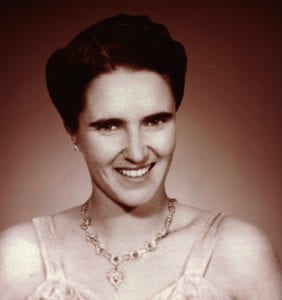This is an abbreviated version of Margaret’s biography, written by her husband Douglas Coop.

Margaret was born at Waimate in South Canterbury in 1927, but spent her young childhood years in a country town in Western Australia. Here, Margaret’s childhood friends were the local animals, including a little joey kangaroo that would jump in and out of her pinny, the multi-coloured parrots, and of course the occasional snake and scorpion. Her family returned to New Zealand in 1935 and Margaret was educated at Christchurch Girls High School where she excelled at both sport and academia.
Margaret passed her University entrance exams at the young age of fifteen. She began her studies at the Otago Medical School in 1946, and graduated in 1950 with high marks. She trained at Christchurch Hospital throughout her final year of Medical School, but despite her academic successes, she was not employed there as a house surgeon because she was a woman.
Fortunately, Margaret was employed by Dunedin Hospital, although her salary was considerably less than her male colleagues for the same work. Whereas the male house surgeons lived at the hospital, the women were housed across the street in an old building known as the ‘nunnery’. To get to the hospital, the women had to battle Dunedin’s changeable weather, and faced the added dangers of darkness during night emergencies.
After her house surgeon years, Margaret lectured in anatomy at the Medical School, and is thought to be the first woman to tutor anatomy in New Zealand. In 1952 she married Douglas Coop, and they both decided to study Ophthalmology—an ideal speciality for a woman. After two years as the eye registrar at Dunedin Hospital they travelled to London to finish their studies. To get to London, they both worked as surgeons, each on a separate ship, and Margaret accompanied by her nine-month-old baby.
Margaret passed her final exams with such high distinction she was awarded a two-year research scholarship, which she took up at the Pathology Department of the Institute of Ophthalmology in London. Ocular Pathology was a new speciality in those days, and she was the first overseas graduate to be accepted. She published a research paper on false tumours of the eye published as the leading article in the British Journal of Ophthalmology. Her work is still cited in the literature, and over the last fifty years her findings have saved many eyes from round the world being removed unnecessarily.
Margaret’s time in London was busy and varied. She worked at Moorfields Eye Hospital Outpatients, and ran the Leprosy Eye Clinic at the Royal Free Hospital. She also represented New Zealand on the International Association of Medical Women, where she had occasional dealings with the Queen Mother and Lady Mountbatten. Every year, Margaret would stand up and address the huge Congress of women doctors from round the world. In 1958, Margaret was invited to Buckingham Palace for the Royal Garden Party. It was a much smaller affair in those days. Various well-known people were there, including Winston Churchill, and Roger Bannister who had been the first to break the 4-minute mile, while in an upstairs window a young Prince Charles and Princess Anne watched proceedings under the eagle eye of their nannie.
Throughout her career, Margaret faced some challenges as a woman in medicine. After training for two years in London, Margaret learnt of an ophthalmic pathologist position in Sydney, Australia. Her application for the position was not well received, as she was told they were seeking a ‘pathologist with an interest in ophthalmology’, rather than an ophthalmic pathologist. Margaret and Douglas instead returned to New Zealand, and in 1962 Douglas was appointed Senior Lecturer in Ophthalmology in Dunedin. Margaret decided to take some time off to look after their three children, and to keep abreast of developments, she asked the Professor of Ophthalmology if she could occasionally sit in to watch in the Eye Outpatient Clinic and watch eye operations. Despite working there for two years as the eye registrar, her request was refused.
The couple later moved to Canberra, where Margaret went into practice as an Eye Specialist. She was also a consultant surgeon to all five hospitals in the Australian Capital Territory and the adjacent part of New South Wales. By this time Margaret was also a Fellow of the Royal Australian College of Ophthalmologists. She and Douglas worked in separate practices, but always operated together. During her Canberra years they travelled widely to conferences in countries round the world and met with many adventures, such as flying in the Concord at twice the speed of sound. But it was a busy life for her, as by this time she also had five children to care for.
Margaret was always ready to help others, and based her life on Christian principles. For many years in Canberra she wore a small brooch stating, ‘You can’t hug a child with nuclear arms.’ Across the years she supported nine different children on World Vision, and contributed to numerous charities. When Margaret retired in 1990, the local newspaper published an editorial praising her work and regretting the loss of her services to the community. This was accompanied by a number of letters of appreciation written by former patients, some of whom continued to send her Christmas cards for many years after she had retired.
After she retired she spent several months at Hanmer Hospital researching drug addiction. Over time, she appreciated her quiet retirement where she could continue her needlework, giving most of what she made to friends and relatives. In 2012, Margaret and Douglas celebrated their 60th wedding anniversary among friends and family.
